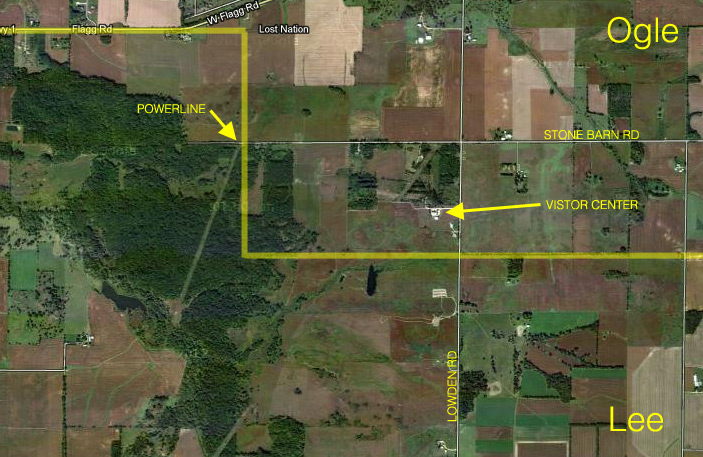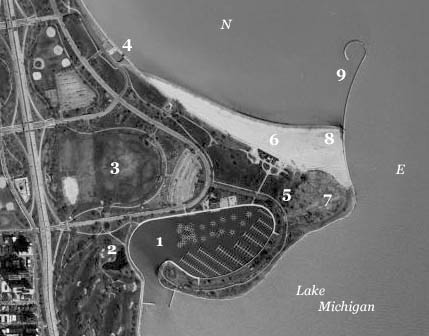Tag Archives: Horned Lark
Nachusa Grassland
Nachusa Grassland is a huge area of high-quality sand-hill prairie with many desirable breeding and wintering species. Grasshopper Sparrow, Henslow’s Sparrow, Savanna Sparrow, Vesper Sparrow, Sedge Wren, Bobolink, Horned Lark are all easily found breeding species. Look and listen for Lark Sparrows along the sandy two-track that goes west from the visitor center. Other sandy-scrub loving species such as Orchard Oriole, Bell’s Vireo, White-eyed Vireo, Blue Grosbeak and Yellow-breasted Chat can be found along this and other trails with appropriate habitat. Look for Willow Flycatcher in the wet areas.
The woods at the west end of Stone Barn Road have had breeding Hooded Warbler. During migrations, the edges along Stone Barn can be excellent for migrating sparrows, which have included Harris’, Le Conte’s and Eurasian Tree. Wintering raptors include Short-eared Owl, Rough-legged Hawk and Northern Harrier. Golden Eagle and Prairie Falcon have been seen in the area regularly during winter, often located by driving the roads to the north and east of the visitor center. Wild Turkey and Ring-necked Pheasant can usually be found along the back-roads in winter, and pheasant can usually be heard almost anywhere during spring and summer.
View Illinois Birding Map in a larger map
County listers take note that the Lee/Ogle county line runs through the northern third of the property:

Montrose Point
To most birders in Chicago, Montrose is a must for any day in spring migration. It is one of the first land masses birds see when they come to shore after a day of migration, and has fantastic habitat for all types of migrants. When one arrives at Montrose early in the morning, the beach is usually the first spot to check. This area is located to the left of the fishhook pier and will usually have a variety of water birds. In migration, one can find Ruddy Turnstone, Greater and Lesser Yellowlegs, Least and Semipalmated Sandpipers, Sanderling, Semipalmated Plover, Whimbrel, Willet, and sometimes even the rare Marbled Godwit. There can be Common and Forester’s Terns on the beach with the gulls, and sometimes uncommon gulls mixed in.
Moving into the native grasslands, one can encounter a variety of new species. Nelson’s and LeConte’s Sparrows are usually the high point for some in fall migration, as they are uncommon migrants and with a bit of searching can be found in the grasses. Short-eared Owls are known to be in the grasses and can be found with luck. One can also find Horned Lark, Lapland Longspur, and other sparrow species. Harris’s Sparrows sometimes can be found in the willows that are throughout the grasses, but they are usually only found once or twice in migration.
In the actual sanctuary, there is a vast system of trails that birders like to walk daily to find all the birds present. The Magic Hedge is located in the north part of the sanctuary and is known as on of the best spots in migration for warblers and other birds at Montrose. In one day, there can be over 20 species of warbler, including less common species like Mourning Warbler, Connecticut Warbler, Black-throated Blue Warbler, Golden and Blue-winged Warbler, and more. There is also a water drip for birds to drink from, which can also hold good migrants since there is a dead tree next to it for birds to perch in. If you come to Montrose in early May, it is almost a guarantee you will run into other local birders at the Magic Hedge, as well as throughout the Sanctuary.
Montrose is also an amazing magnet for uncommon to rare birds. Bob Hughes has recorded over 330 species at Montrose, and recent uncommon birds have been Burrowing Owl, Western Grebe, Black-legged Kittiwake. Many first state records have been found at Montrose, and that is most likely due to the numbers of birders that travel there. Bob Hughes has a website dedicated to Montrose birding, which can be viewed at here: http://theorniphile.info/montrose_primer.html
1) Montrose Harbor
2) Golf Course Pond
3) Cricket Hill
4) Wilson Boat Launch
5) The Magic Hedge
6) Montrose Beach
7) The Meadow
8) Montrose Dunes
9) Fishhook Pier
(Courtesy of Bob Hughes and the Montrose Primer (http://theorniphile.info/montrose_primer.html)
Double T State Fish and Wildlife Area
Double T is a patchwork of prairie, agricultural and old stripmine. The main attraction is Upland Sandpipers that nest in the fields along Cypress Rd. to the east of Co. Rd. 21.
Other breeding or summering species include Bobolink, Henslow’s Sparrow, Grasshopper Sparrow, Savannah Sparrow, Vesper Sparrow, Willow Flycatcher, Horned Lark, Blue Grosbeak, Yellow-breasted Chat, Bell’s Vireo, Northern Harrier.
During migration, the wet spots and fields can be very good for shorebirds and ducks, and the patches of foxtail grass (especially on the south side of Cypress) are good places to look for LeConte’s and Nelson’s Sparrows in September and October.
View Illinois Birding Map in a larger map

